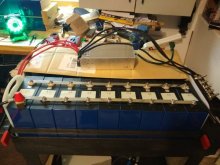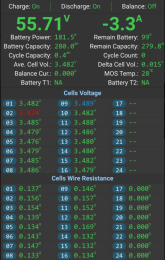You know... I'm gonna just be blunt about it. Undersizing is very easy to do. Being "cheap" and bodging thing (squeezing copper pipe, seriously ?) is certainly NOT the way to buy a solid & reliable system. Cheap is NOT Equal to Frugal !
Wanna build a 1000HP Corvette and put Brakes from a 1976 Chevette on it with Bicycle tires ?
Oversizing a little over is generally a good idea because Things Happen, often unexpectedly and then sometimes just evolution because needs / wants change.
I always told people that if you figure everything out and decide that a 4Kw Inverter (excl, surge) would be OK I would suggest get the Next Size up but guess what, I'd get CRapped on for it. Then a year later Mr Smarty is upgrading their Inverter.... I don't tell folks anymore cause I don't need to be crapped on for common sense.
I first built to run with 3KW Inverter with Big Lead Battery Bank, 12 months later I was upgrading to 4KW Inverter... Replaced ALL my 2/0 with 4/0 ($$$ ouch ) new breakers, fuses (more $$$ ouch) then to incorporate Lithium (LFP) another year afterwards... more $$$
BOS = Lots of cash and if you built to one spec at first, the odds are you will be upgrading something later. BTW, just about everyone who goes solar does upgrade some things within 12-36 months to increased need or just under planned at the start.
As the 500A Charge / Discharge.... the 280AH cells are C1 (280A) max output rate (for the commodity cells) and they are recommended to not exceed .5C
I read that long thread between you and Smoothjoey... made my brain hurt.... be careful about getting caught up in minutia.
Please do yourself a favour, remember these are Commodity Cells and not fully matched & batched Premium cells. Ensure your expectations match what you bought.
Just a tidbit of personal info. I was an Core IT System Engineer (Military & Gov) and involved in fault tolerance & failover systems, which encompassed literally every aspect and potential scenarios... Triple Redundancy = Critical life ! Hence where I gained my "hard wired programming" of "Do it right the 1st Time." There is not much room for "just good enough". As I am Offgrid, Rural & Remote and can be subjected to "extreme" weather (1 foot + snowfalls) to twisters in summer ++ I have to depend on my system because I could be property bound for periods... dependability, reliability & safe are essential and approached as such.








